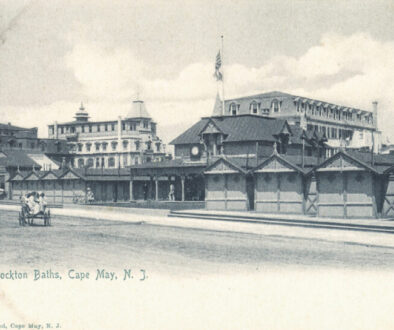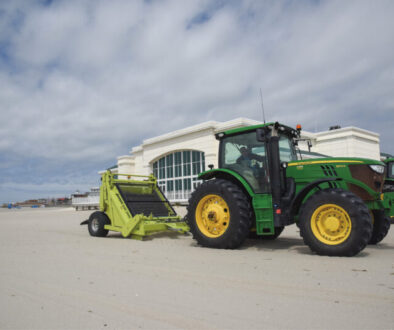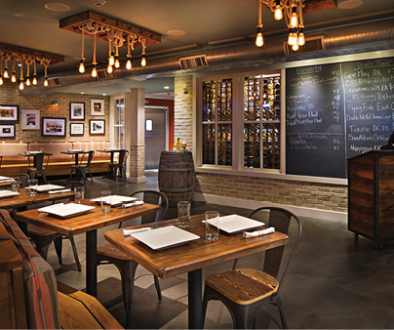Cedar in the Pine Barrens
The Cape May connection to a vintage sawmill
Down narrow country roads, deep in the heart of the Pine Barrens, sits one of the last Atlantic white cedar sawmills in South Jersey. Turn onto a dirt track in Atlantic County, past a crumbling 100-year-old farmhouse, and in front of you are the stacks of wood and metal sheds of Schairer Brothers Sawmill. Operated for over 80 years in Egg Harbor City by three generations of the Schairer family, this sawmill has witnessed and supported the area’s growth and development.
And even though it’s “up the road,” it has also played a critical part in preserving Cape May County’s historic past. As one of the few sources of building materials made from New Jersey ‘s indigenous Atlantic white cedar, Schairer Brothers has been an important resource in preserving Cape May City’s National Historic Landmark status.

Most historic buildings in the city were originally built of cedar from New Jersey’s Pinelands. And over time, many of their clapboard and cedar shakes have been replaced using wood from Schairer Brothers.
“My grandfather started the mill in the 1930s,” says Paul Schairer, an affable man in his mid-50s who now owns it. Grandfather Schairer was a local carpenter who built houses using trees he felled in his own woods. After a few years of building, he decided to open his own sawmill. With a half dozen sons to help, he had a ready-made workforce.
Soon, they were joined by the third generation of the family, which includes Paul Schairer. “I started working here when I was 13,” he remembers, “sweeping floors and bailing excelsior.” Excelsior, the wood shavings that drop when lumber is cut, is sold for dog bedding. After Schairer finished school, he went to work in the family business full time.
It is clear as he shows off the mill, its old machines and the products they turn out, that Schairer loves what he does. “It’s rewarding when people show me a picture of siding and shingles,” he says. “I know it will be there 30 years or more. You know that you produced something that has value.”
He jokes that his machines are “dinosaurs.” Some are 70 or 80 years old, likely used by his grandfather. Some machines cut off the tree bark; others saw the logs into boards or slice them into shingles. He has to sharpen each tooth on every blade by hand.
“My dad always said that wood that’s native to the environment holds up in that environment,” says Schairer. Indeed, the oils and acids inherent in the cedar that grows along the sides of New Jersey’s freshwater swamps and streams make it highly resistant to moisture, decay, and bugs.

It is so water resistant that trees buried in the swamps for decades have been used for building. In the 1800s, the “sunken forest” of Cape May’s Great Cedar Swamp was harvested. Submerged trees were pulled from the water and cut for use. In the 1930s, according to a federal Works Progress Administration report, another submerged forest—four to 20 feet deep in Cumberland County—was being mined for timber that was brought to Dennisville to be sawed into planks.
Cedar, one of the most versatile woods, was widely used when Paul Schairer’s grandfather opened his mill. And there were many such mills at the time throughout the area. Water resistant and lightweight, cedar was highly prized by oystermen and fishermen for their boats. Farmers throughout south Jersey transported their lettuce, blueberries, and other produce in cedar crates. Fences were constructed from it. And, of course, cedar boards covered the outside of houses, and cedar shakes tiled the roofs.
When Paul’s dad and uncles ran the mill, they employed 30 to 40 men, and they harvested about 100 acres. “Thirty years ago, I was working 12-hour days making cedar fences,” remembers Schairer.
But times changed. Synthetic materials have widely replaced cedar. Boats are primarily constructed of fiberglass and plastic. Asphalt shingles now cover roofs. Many houses sport vinyl siding. And vinyl is also widely used for fences. At the same time south Jersey lost many of its farms, and most remaining farmers buy plastic containers for their fruits and vegetables.
Today, Schairer Brothers Sawmill employs only a handful—at times a dozen—people. It primarily harvests 10 to 20 acres of family land, and occasionally buys old growth wood from area cranberry and other farms to meet the needs of its customers.
The mills that once peppered south Jersey, sawing Atlantic white cedar, have largely disappeared. Here and there, such as in Cumberland County, a one-man mill operates.
However, “there’s definitely a demand” for sawmills to cut cedar, says Schairer. In fact, one of his own sources for wood, Colin McLaughlin, plans to open his own sawmill soon. McLaughlin intends to cut not only cedar, but other wood as well.
After Superstorm Sandy downed thousands of cedars in Ocean County’s Double Trouble State Park, McLaughlin won a state contract to clear the trees and sell them. But he has had to ship them to North Carolina for milling. An important client for him is Colonial Williamsburg, VA, which uses the old cedar trees to repair and restore its historic buildings.



Closer to home, many owners of the historic houses of Cape May rely on Schairer Brothers wood. Paul Schairer sells about one-third of his wood to Cape May homeowners and contractors.
Having access to Atlantic white cedar nearby is important to preserving the city’s history. Cape May’s preservation rules require homeowners of key or contributing buildings in the historic district to preserve existing cladding and roofs. But if that is not possible then they must be replaced “in kind replicating the original in both materials and design.”
“The standards are clear,” says Warren Coupland, chairman of Cape May City’s Historic Preservation Commission. “Wood must replace wood, and that means red or white cedar.”
Homeowner options from local suppliers are western red cedar from Canada or the Pacific Northwest, or a Canadian eastern white cedar. Some builders question whether this wood, adapted to a different, colder, climate is as good for building in South Jersey as indigenous cedar.
There is also a new type of New Jersey Atlantic white cedar, engineered for quick growth, that some local suppliers have available. Because there are no South Jersey mills for cedar other than Schairer Brothers, this wood is shipped to North Carolina for milling.
Some builders say it is not as strong as old growth Pineland timber. And they find it more expensive. For some projects they cannot get the size and shape of the lumber they need.
John Gamble is restoring a 19th-century Victorian home on Lafayette Street for its Pennsylvania owners. Some of the old existing white cedar siding is still good, he says, but many of the boards have to be replaced.
The old boards are ½-inch all the way across. The problem, he explains, is that he can’t get that anywhere, either in red or white cedar. Only tapered boards are available, and they don’t give the same shadow line. If he replaced all the wood it would be more expensive for the owner, and a lot of the house’s history would be lost.
“If we put beveled siding on, it doesn’t look the same,” he says. “And we are keeping everything as historical as possible.” Gamble adds that he might be able to have wood milled specifically for his job, by an out of state mill, but that too would be more costly.
“The good thing about Schairer Brothers,” states Gamble, who has built several houses in Cape May from their cedar, “is they will mill anything I want to size. And they are right here. I don’t need to order out of state. The best thing is convenience.” And, he adds with a smile, “He never says no. They are sweethearts there.”


Tracie and Steve Ferra are helping their carpenter restore the 19th-century Victorian West Cape May home they recently bought. West Cape May’s historic district has similar cladding and roof preservation rules as Cape May City. The old walls of their house were in such bad condition that the building had to be stripped to its beams.
But, says Tracie, “It’s an historic house and I am going to make it look like it was.” So, they were happy to learn that they could buy from Schairer Brothers the same Atlantic white cedar clapboard they had just removed. “It’s from this area and it weathers well in this area,” notes Steve. “It’s insect and mold resistant.”
About a dozen years ago Stone Harbor’s Wetlands Institute needed a new roof. The Institute’s goal is to preserve and protect coastal ecosystems, so its officials insisted that the roof be made from wood indigenous to this area.
Barry Mahon, owner of Coastal Siding, which did the work, contacted Schairer Brothers for the roof shingles. He also used their Atlantic white cedar on the American Legion Post building in Stone Harbor, which is the converted Tatham Life Saving Station, built in 1895.
The old growth wood that Schairer Brothers sells is “better wood, not as many marks on it, stronger,” Mahon says, comparing it to the cedar trees engineered for fast growth.
The Pinelands, over one million acres of land, is the largest open space on the eastern seaboard between Richmond and Boston. It spreads over seven counties and covers about one-fifth of New Jersey. In the 1970s, with New Jersey seeing intense urban sprawl and well on its way to becoming the most densely populated state, Congress designated the Pinelands as the country’s first national reserve.

The objective was to protect the natural, physical and cultural qualities of the region, while allowing, but coordinating, agriculture, residential and commercial activity. The state was tasked with implementing this. It created the Pinelands Commission, which in turn set up conservation and growth zones, mandating strong environmental standards.
One critical goal was to protect the forests, regulate lumbering and ensure regeneration of the trees, especially the Atlantic white cedar. The tree is considered “a globally rare species,” according to a state forester.
New Jersey created best management practices to ensure that this happens on the vast tracts owned by the state. But, says one official, lack of money and staff is significantly hindering the management of state land.
Private landowners must also meet these standards. Paul Schairer cuts his timber in line with 10-year forest management plans that must be approved before he can receive his permit. They map out his timber tracts, how he will regenerate the cedar, how his work affects local plant and animal species. He can’t harvest trees at certain times of the year, for example, in order to protect the timber rattlesnake, which hibernates in the roots of cedars.
Certified Forester Bob Williams, owner of Pine Creek Forestry, prepares the management plans for Schairer Brothers, and for most of the other private lands in the Pine Barrens. The cedar forests are in trouble, he warns. “We need to manage the forests based on science.” The problem is that up until “the 1970s, 1980s, people just cut the woods and walked away, and sometimes it came back, and sometimes it didn’t.”
Cedar needs sunlight to regenerate and grow, and controlled cutting is important to a healthy cedar forest. “The uninformed get crazy when we cut a tree,” Williams says, “but in the case of cedar it’s the only way to regenerate it. We need to open up the forest. Now we are at the tipping point. We need to cut some to save the forest.”
He gives an example of one swamp area, owned by the Schairer family, that was harvested in the 1930s. It grew back and was cut again in the 1960s. Then, it was cut once more in the 1990s. It is now regenerating again.
Cedars take about 30 years to replenish, but maples grow much faster, which is why, after the cedars are cut, the area cannot be left alone. “If you just cut cedar and leave a maple, there will be a maple swamp,” explains Paul Schairer. “The hardwoods would take over.”
The two men are linked by cedar, in a way, their missions hinged, intentional or not. “Paul is intertwined with the culture and history of south Jersey,” says Williams. “And I need him to help take care of the forest.”



